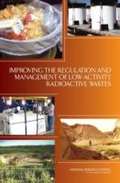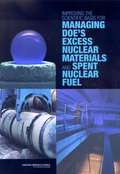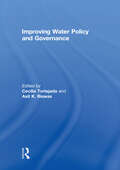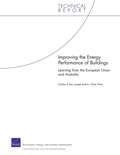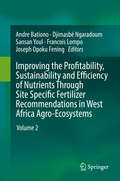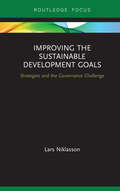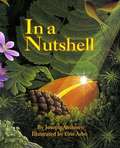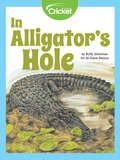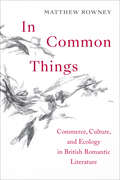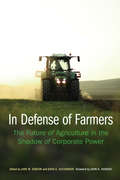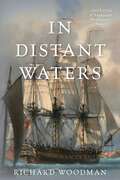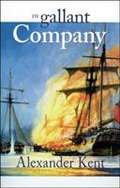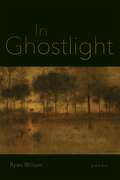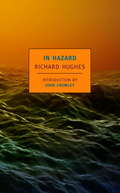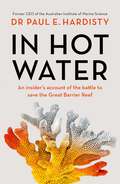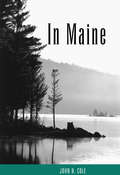- Table View
- List View
Improving The Regulation And Management Of Low-activity Radioactive Wastes
by National Research Council of the National AcademiesThe largest volumes of radioactive wastes in the United States contain only small amounts of radioactive material. These low-activity radioactive wastes (LAW) should be regulated and managed according to the degree of risk they pose for treatment, storage, and disposal. Current regulations are based primarily on the type of industry that produced the waste-the waste's origin-rather than its risk. In this report a risk-informed approach for regulating and managing all types of LAW in the United States is proposed. Implemented in a gradual or stepwise fashion, this approach combines scientific risk assessment with public values and perceptions. It focuses on the hazardous properties of the waste in question and how they compare with other waste materials. The approach is based on established principles for risk-informed decision making, current risk-informed initiatives by waste regulators in the United States and abroad, solutions available under current regulatory authorities, and remedies through new legislation when necessary.
Improving The Scientific Basis For Managing Doe's Excess Nuclear Materials And Spent Nuclear Fuel
by Committee on Improving the Scientific Basis for Managing Nuclear Materials Spent Nuclear Fuel through the Environmental Management Science ProgramThis study identifies research opportunities for storage, recycle, reuse, or disposal of nuclear materials and spent nuclear fuel. Most of the materials dealt with in this report have not been declared as waste. The report completes the fifth in a series of studies requested by the EMSP to assist in developing its calls for proposals and evaluating proposals on this issue. There is no subject index. Annotation ©2004 Book News, Inc. , Portland, OR (booknews. com)
Improving Water Policy and Governance (Routledge Special Issues On Water Policy And Governance Ser.)
by Asit K. Biswas Cecilia TortajadaOld forms of governance in both public and private sectors are becoming increasingly irrelevant because of rapidly changing conditions. Because of these changes, both governance processes and the scope of the institutions through which power is exercised throughout society may have to undergo a radical break with the past and prevailing models of governance. Water sector is an integral part of the global system. Consequently, its governance processes and the institutions responsible for its management must change as well in order to cope with the current challenges and potential future changes. Because of these current and future changes, water governance may have to change more during the next 20 years compared to the past 2000 years, if societal expectations are to be successfully met. All these changes will make water governance more complex than ever before witnessed in human history. Improving water governance will require good and objective analyses of case studies from different parts of the world as to what has worked, why and the enabling environments under which good governance has been possible. The present volume analyses case studies of good water governance from different parts of the world, and for different water use sectors. It concludes with an analysis of the critical issues that should be considered for water governance and a priority research agenda for improving water governance in the future. This book was published as a special issue of the International Journal of Water Resources Development.
Improving the Energy Performance of Buildings
by Charles P. Ries Oliver Wise Joseph JenkinsThis study examines how policies to increase energy efficiency in buildings in the European Union and Australia have worked and draws implications for the design of similar public policies for the United States. It appears that effective policies to promote energy efficiency can be devised using information disclosure, building codes, financial incentives, and benchmarking. Insights are presented to help designers of analogous U.S. policies.
Improving the Profitability, Sustainability and Efficiency of Nutrients Through Site Specific Fertilizer Recommendations in West Africa Agro-Ecosystems
by Andre Bationo Djimasbé Ngaradoum Sansan Youl Francois Lompo Joseph Opoku FeningAs part of its efforts to improve fertilizer use and efficiency in West Africa, and following the recent adoption of the West African fertilizer recommendation action plan (RAP) by ECOWAS, this volume focuses on IFDC's technical lead with key partner institutions and experts to build on previous and current fertilizer recommendations for various crops and countries in West Africa for wider uptake by public policy makers and fertilizer industry actors.
Improving the Profitability, Sustainability and Efficiency of Nutrients Through Site Specific Fertilizer Recommendations in West Africa Agro-Ecosystems
by Andre Bationo Djimasbé Ngaradoum Sansan Youl Francois Lompo Joseph Opoku FeningAs part of its efforts to improve fertilizer use and efficiency in West Africa, and following the recent adoption of the West African fertilizer recommendation action plan (RAP) by ECOWAS, this volume focuses on IFDC's technical lead with key partner institutions and experts to build on previous and current fertilizer recommendations for various crops and countries in West Africa for wider uptake by public policy makers and fertilizer industry actors.
Improving the Sustainable Development Goals: Strategies and the Governance Challenge (Routledge Focus on Environment and Sustainability)
by Lars NiklassonImproving the Sustainable Development Goals evaluates the Global Goals (Agenda 2030) by looking at their design and how they relate to theories of economic development. Adopted unanimously by the member states of the United Nations (UN) in 2015, the goals are remarkable for the global commitment on a set of targets to reach by 2030, but also for the lack of a strategy of implementation. The choice of appropriate action is handed over to individual governments, some of which are limited by their lack of resources. This book explores how implementation of the sustainable development goals (SDGs) can be developed, especially in developing countries. The content, strengths and weaknesses of the SDGs are critically examined, alongside their relationship to ongoing academic research. The authors also investigate the actions of governments over the past three years by looking at the national strategies they have presented at annual meetings of the UN High-Level Political Forum. Improving the Sustainable Development Goals takes a critical but constructive approach, pointing out risks as well as possible remedies. The SDGs are seen as an opportunity for a global conversation on what works in solving some fundamental problems relating to poverty and environmental degradation. With the inclusion of a chapter by Tobias Ogweno, former member of the Kenya’s UN mission, this book will appeal to all those who are interested in policy analysis with a focus on development issues.
In A Nutshell (Sharing Nature With Children)
by Joseph AnthonyAn acorn grows into a mighty oak, helps sustain other life, and eventually dies and continues to give life to others.
In Alligator's Hole
by Buffy Silverman Diane BlasiusDuring the rainy season in the marshlands, Alligator has almost nothing to eat. When the dry season comes, Alligator digs a hole in the pond and waits for the animals to return. Without Alligator and her hole, there would be far fewer animals living in the marsh.
In Common Things: Commerce, Culture, and Ecology in British Romantic Literature
by Matthew RowneyThe hardness of stone, the pliancy of wood, the fluidity of palm oil, the crystalline nature of salt, and the vegetable qualities of moss – each describes a way of being in and understanding the world. These substances are both natural objects hailed in Romantic literature and global commodities within a system of extraction and exchange that has driven climate change, representing the paradox of the modern relation to materiality. In Common Things examines these five common substances – stone, wood, oil, salt, and moss – in the literature of Romantic period authors, excavating their cultural, ecological, and commodity histories. The book argues that the substances and their histories have shaped cultural consciousness, and that Romantic era texts formally encode this shaping. Matthew Rowney draws together processes, beings, and things, both from the Romantic period and from our current ecological moment, to re-invoke a lost heritage of cultural relations with common substances. Enabling a fresh reading of Romantic literature, In Common Things prompts a reevaluation of the simple, the everyday, and the common, in light of their contributions to our contemporary sense of ourselves and our societies.
In Defense of Farmers: The Future of Agriculture in the Shadow of Corporate Power (Our Sustainable Future)
by Sara Alexander Jane Gibson John K. HansenIndustrial agriculture is generally characterized as either the salvation of a growing, hungry, global population or as socially and environmentally irresponsible. Despite elements of truth in this polarization, it fails to focus on the particular vulnerabilities and potentials of industrial agriculture. Both representations obscure individual farmers, their families, their communities, and the risks they face from unpredictable local, national, and global conditions: fluctuating and often volatile production costs and crop prices; extreme weather exacerbated by climate change; complicated and changing farm policies; new production technologies and practices; water availability; inflation and debt; and rural community decline. Yet the future of industrial agriculture depends fundamentally on farmers’ decisions.In Defense of Farmers illuminates anew the critical role that farmers play in the future of agriculture and examines the social, economic, and environmental vulnerabilities of industrial agriculture, as well as its adaptations and evolution. Contextualizing the conversations about agriculture and rural societies within the disciplines of sociology, geography, economics, and anthropology, this volume addresses specific challenges farmers face in four countries: Bolivia, Brazil, Canada, and the United States. By concentrating on countries with the most sophisticated production technologies capable of producing the largest quantities of grains, soybeans, and animal proteins in the world, this volume focuses attention on the farmers whose labors, decision-making, and risk-taking throw into relief the implications and limitations of our global industrial food system. The case studies here acknowledge the agency of farmers and offer ways forward in the direction of sustainable agriculture.
In Defense of Plants: An Exploration into the Wonder of Plants
by Matt Candeias PhDCultivate Inner Peace Through Positive Affirmations and Spiritual Meditation“52 Ways to Live the Course in Miracles is a compact rendition of how to live with love and forgiveness at the center of our lives." ─Allyson Gracie, Retailing Insight#1 Best Seller in SpiritualismFind the path to inner peace through a weekly guide of spiritual meditations and positive affirmations.Use Karen Casey’s 52 positive affirmations and meditations to find inner peace. We all face struggles that can leave us feeling broken and hopeless. But peace and healing are always available to us if we are open to them. Karen Casey is a beloved author who has helped millions onto the road to recovery with her inspirational self-help and meditation writings. In this inspirational book, Karen takes readers on a journey towards peaceful living by sharing how she has found serenity in her own life. Karen teaches readers that the goal is not perfection, but rather progress towards creating a life of love and peace. Cultivate a simpler, slower, more love-filled life. When Karen Casey was struggling with addiction, she found life-changing inspiration in Helen Schucman’s book, A Course in Miracles. In 52 Ways to Live the Course in Miracles, she shares the ideas she discovered in Helen Schucman's book and the spirituality that we can all bring to our own lives.Find inside:Meditations and affirmations that lead to a simpler, slower lifeInsights into Helen Schucman’s A Course in MiraclesStories of the author’s own struggles and triumphs on her path to healingIf you enjoyed reading other books like Practicing Mindfulness, The Untethered Soul Guided Journal, or A Year of Mindfulness, then you’ll love 52 Ways to Live the Course in Miracles.
In Distant Waters: A Nathaniel Drinkwater Novel (Nathaniel Drinkwater Novels)
by Richard WoodmanFrom the tide-torn waters of the Thames, where Captain Nathaniel Drinkwater is compelled to handle a deserter, to the seas off Cape Horn, storm-scoured gateway to the Pacific, the great cruiser Patrician is tense with the threat of mutiny. Despite this, Drinkwater captures a Spanish frigate and meets the stunning Doña Ana Maria, daughter of the Commandante of San Francisco. But having disturbed a hornet&’s nest of colonial intrigue, Drinkwater finds that the Spanish are eager to humiliate him and the Royal Navy. Moreover, a Russian battleship lurks somewhere offshore, pursuing Tsar Alexander&’s dark plans. Caught between two formidable enemies, Drinkwater&’s mission is made impossible by treachery.But chance brings the aid of Doña Ana Maria and a mysterious mountain man. In the distant waters of this beautiful and remote region, Drinkwater struggles to carry out his mission and is struck with the most extraordinary twist of fortune in his eventful life.
In Dog We Trust: A Celebration of Those Who Never Let Us Down
by Mary ZaiaMary Zaia's In Dog We Trust is a heartwarming coffee table book for dog loversAs any dog lover knows, people may disappoint, betray, and leave you hanging, but dogs never do. With adorable photos of all kinds of dogs—purebreds and mutts alike—along with uplifting quotes about friendship, loyalty, and connection, In Dog We Trust is the celebration of human-canine love we all need.
In Gallant Company (Richard Bolitho Novels #3)
by Alexander KentAs the American Revolution rages on the mainland, the British Navy prepares for action at sea. Against a growing fleet of American and French privateers, the navy must maintain its blockade of Washington's vital military supplies. Caught up in the turmoil, junior officer Richard Bolitho finds himself having to make momentous decisions in the heat of battle--decisions that could affect the lives of many men and, perhaps, even the fate of nations.
In Ghostlight: Poems (Southern Messenger Poets)
by Ryan WilsonIn Ghostlight, a long-awaited second collection of original poems by Ryan Wilson, considers the haunting of the contemporary mind. With virtuosic formal variety and masterful craft, these poems range from rural America to Italy to the Holy Land, as they chronicle the dynamism of a spiritual odyssey toward the eternal through both past and present. Wilson employs sonnets, Pindaric and ballad stanzas, alliterative hemistichs in imitation of the Anglo-Saxon, and other ancient forms to enlighten the modern experience, from smartphones and Facebook to jumbo jets, entangled in a reciprocal relationship with myths, sacred literature, and traditions.Revealing that the past and the everlasting can inform the present at any given moment, In Ghostlight conveys how a vision acknowledging this dual illumination helps us understand ourselves and others in our fraught, complex era.
In Hazard
by John Crowley Richard HughesThe Archimedes is a modern merchant steamship in tip-top condition, and in the summer of 1929 it has been picking up goods along the eastern seaboard of the United States before making a run to China. A little overloaded, perhaps--the oddly assorted cargo includes piles of old newspapers and heaps of tobacco--the ship departs for the Panama Canal from Norfolk, Virginia, on a beautiful autumn day. Before long, the weather turns unexpectedly rough--rougher in fact than even the most experienced members of the crew have ever encountered. The Archimedes, it turns out, has been swept up in the vortex of an immense hurricane, and for the next four days it will be battered and mauled by wind and waves as it is driven wildly off course. Caught in an unremitting struggle for survival, both the crew and the ship will be tested as never before. Based on detailed research into an actual event, Richard Hughes's tale of high suspense on the high seas is an extraordinary story of men under pressure and the unexpected ways they prove their mettle--or crack. Yet the originality, art, and greatness of In Hazard stem from something else: Hughes's eerie fascination with the hurricane itself, the inhuman force around which this wrenching tale of humanity at its limits revolves. Hughes channels the furies of sea and sky into a piece of writing that is both apocalyptic and analytic. In Hazard is an unforgettable, defining work of modern adventure.
In Hot Water: Inside the battle to save the Great Barrier Reef
by Paul E. HardistyIn the ongoing climate wars, the Great Barrier Reef has become a symbol of everything that we have to lose from global warming. For years, reports of the world-famous coral being irreversibly bleached have fuelled an ideological battle between those fighting to stop the damage and those who insist the danger is overblown.Paul Hardisty found himself in the middle of this fight during his six years as CEO of the Australian Institute of Marine Science. In this fascinating, candid and urgent book, he dives into the history of the reef and cuts through the rhetoric to chart the circumstances and acceleration of its decline, as well as the determined efforts to save it.In Hot Water is a crucial look inside the battle to save one of Australia's greatest treasures, describing what must be done to preserve it, and what is at risk if we fail to do so.
In Maine: Essays On Life's Seasons
by John N. ColeCollection of essays by the late John N. Cole. Cole writes with passion about his life, the outdoors and the glorious rhythms of nature. Originally released in the 1970s and unavailable for two decades, this revised Islandport Press edition features new essays and photographs. For decades, John Cole wrote with passion about his life, the outdoors and the glorious rhythms of nature. In Maine, like all his essays and books, draws deep from his lifelong partnership and his fascination with the natural world from commercial fishing in the waters off Long Island, New York to chasing stripers in Casco Bay, Maine, to quietly observing the shifting winds that roll across the local meadow and the annual change of seasons, a ritual he finds exhilarating. "Few realities life can muster are capable of destroying the zest and richness of September and October in this northeast," he writes. Cole has gained insight and contemplated potential lessons during his journey. He notes the changes that have come to the world and those that are coming. And he laments the basics of nature that too often pass unnoticed today, but remain important parts of our past and possibly our future. "Men cannot live without knowing... knowing which way the wind blows, which way the rain falls, how the sea surges, the land lives and the forest dies." To do so, he says, is unnatural.In Maine, originally published in 1974 and available again for the first time in 25 years, features essays that appeared in the Maine Times during its formative years but remain as fresh and insightful as ever. The revised edition also includes new essays that sparkle with the same energy and enthusiasm as Cole's earlier work.
In My Garden
by Charlotte ZolotowWelcome the outdoors inside for story time with this classic tale of a garden changing through the seasons.A young girl and her older companion watch birds, fly a kite, plant flowers, and play in the snow, watching flowers bloom and leaves fall as the year passes. This quiet story celebrates the simple joys found close to home, and the importance of sharing those experiences with the ones you love. A perfect story time pick for any season, In My Garden explores the natural marvels of the world around us and encourages young readers to think about what they love best throughout the year. Written by picture book master Charlotte Zolotow and originally published in 1960, this elegant reimagining of In My Garden features all-new illustrations by accomplished author-illustrator Philip Stead. His delicate illustrations and gentle, colorful palette bring new life and meaning to this classic tale-- a beautiful tribute to the experience of childhood, and a thank you to a master storyteller.
In November
by Cynthia Rylant Jill KastnerIn November, the air grows cold and the earth and all of its creatures prepare for winter. Animals seek food and shelter. And people gather together to celebrate their blessings with family and friends. Cynthia Rylant's lyrical language and Jill Kastner's rich, cozy paintings capture the cherished moments of this autumn month--the moments we spend together and the ones we witness in the world around us.
In November (Into Reading, Trade Book #6)
by Cynthia Rylant Jill Kastner<p>NIMAC-sourced textbook. In November, the air grows cold and the earth and all of its creatures prepare for winter. Animals seek food and shelter. And people gather together to celebrate their blessings with family and friends. <p>Cynthia Rylant's lyrical language and Jill Kastner's rich, cozy paintings capture the cherished moments of this autumn month--the moments we spend together and the ones we witness in the world around us.</p>
In Our Backyard: Keeyask and the Legacy of Hydroelectric Development
by Aimée Craft Jill BlakleyBeginning with the Grand Rapids Dam in the 1960s, hydroelectric development has dramatically altered the social, political, and physical landscape of northern Manitoba. The Nelson River has been cut up into segments and fractured by a string of dams, for which the Churchill River had to be diverted and new inflow points from Lake Winnipeg created to manage their capacity. Historic mighty rapids have shrivelled into dry river beds. Manitoba Hydro's Keeyask dam and generating station will expand the existing network of 15 dams and 13,800 km of transmission lines. In Our Backyard tells the story of the Keeyask dam and accompanying development on the Nelson River from the perspective of Indigenous peoples, academics, scientists, and regulators. It builds on the rich environmental and economic evaluations documented in the Clean Environment Commission’s public hearings on Keeyask in 2012. It amplifies Indigenous voices that environmental assessment and regulatory processes have often failed to incorporate and provides a basis for ongoing decision-making and scholarship relating to Keeyask and resource development more generally. It considers cumulative, regional, and strategic impact assessments; Indigenous worldviews and laws within the regulatory and decision-making process; the economics of development; models for monitoring and management; consideration of affected species; and cultural and social impacts. With a provincial and federal regulatory regime that is struggling with important questions around the balance between development and sustainability, and in light of the inherent rights of Indigenous people to land, livelihoods, and self-determination, In Our Backyard offers critical reflections that highlight the need for purposeful dialogue, principled decision making, and a better legacy of northern development in the future.
In Plenty's Woods: Poems
by Brendan GalvinIn Plenty’s Woods, a final collection of poems by Brendan Galvin, returns to many settings and subjects that fascinated him: the natural world, particularly the birds around his home off Cape Cod in Truro, Massachusetts; the attractions and dangers of the seashore; his Irish heritage, including its rich language and folk culture; and the pleasures of domestic life. He explores the natural order in dialogue—sometimes playful, sometimes grave—with a personal realm of love, mortality, and the history embedded in the language we exchange.Whether describing the birdlife he sees even during wintertime, speculating on the voices heard by sleeping sailors at sea, or writing a love poem he cannot read to his departed wife, Galvin remains a poet of consummate skill and powerful emotion who works the narrative lyric with great precision of attention, flexibility of tone, and expressivity of figure.
In Praise of Floods: The Untamed River and the Life It Brings (Yale Agrarian Studies Series)
by James C. ScottJames C. Scott reframes rivers as alive and dynamic, revealing the consequences of treating them as resources for our profit Rivers, on a long view, are alive. They are born; they change; they shift their channels; they forge new routes to the sea; they move both gradually and violently; they can teem (usually) with life; they may die a quasi-natural death; they are frequently maimed and even murdered. It is the annual flood pulse—the brief time when the river occupies the floodplain—that gives a river its vitality, but it is human engineering that kills it, suppressing the flood pulse with dams, irrigation, siltation, dikes, and levees. In demonstrating these threats to the riverine world, award-winning author James C. Scott examines the life history of a particular river, the Ayeyarwady (Irrawaddy) of Burma, the heartland and superhighway of Burman culture. Scott opens our understanding of rivers to encompass their entirety—tributaries, wetlands, floodplains, backwaters, eddies, periodic marshlands, and the assemblage of life forms dependent on rivers for their existence and well-being. For anyone interested in the Anthropocene and the Great Acceleration, rivers offer a striking example of the consequences of human intervention in trying to control and domesticate a natural process, the complexity and variability of which we barely understand.
